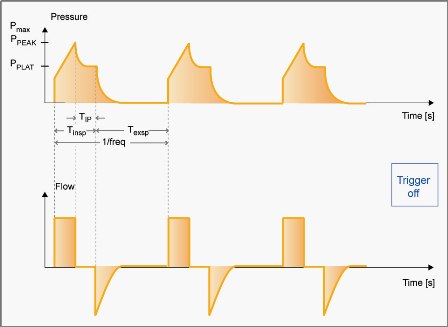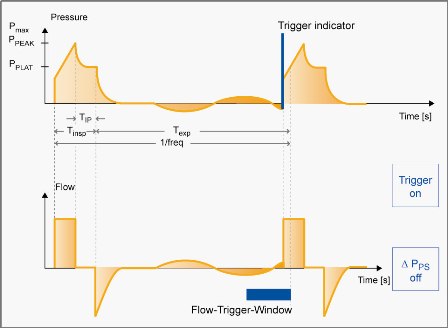- Front View
- Rear View
- 360° View
- General User Interface
- Advanced Monitoring
- Ventilation Modes
- Abbreviations
- Symbols
Volume controlled ventilation
Volume controlled ventilation with constant inspiration flow

Intended use:
Anesthesia in relaxed or partially relaxed patients with healthy lungs and in patients with cranio-cerebral trauma. The goal is to maintain a constant volume or a constant "etCO2".
Volume-controlled ventilation mode with fixed mandatory tidal volume VT and frequency freq. (former IPPV), as well as with optional synchronization activation (former SIMV(VC)) and variable pressure support for spontaneous breathing efforts (former SIMV(VC)+PS, optional).
The respiratory cycle is defined through the frequency freq., the inspiratory time TINSP, the inspiratory pause time TIP:TINSP and the tidal volume VT.
The Volume controlled mode reaches all patient populations (20 - 1400 ml, f 3 - 100 min-1) without changing components and reduces the inspiratory system compliance and permits correct delivery of set tidal volume from the first breath (compliance compensation).
Synchronization of volume controlled ventilation and spontaneous breathing

Synchronization is activated as soon as a trigger sensitivity value is entered. The message "sync" is displayed in the ventilation mode status field on the screen.
The flow trigger sensitivity controls the synchronization. The maximum time delay between the controlled ventilation breaths is adjusted by means of the frequency. To keep the frequency constant in the event of a premature triggering, the time is equalized in the next ventilation cycle.
A ventilation breath triggered by the patient is indicated by a continuous line in the pressure curve and in the flow curve (trigger indicator). The active flow trigger window corresponds to the last 25% of the relevant expiratory time.
